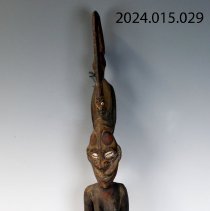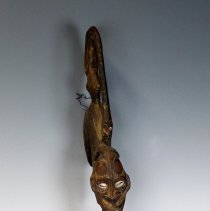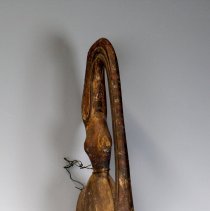Object Record
Images



Metadata
Catalog Number |
2024.015.029 |
Object Name |
Carving |
Description |
This ritual carving originates from the Akehon People of the Sepik River mapnik region in New Guinea, Oceania. Carved figures from Papua New Guinea, Oceania normally represented gods, deities, or ancestral heroes. They were sometimes made free-standing but are also found as part of a larger object like the top of a house pole. New Guinea figures vary in size from very small charms hidden on one's person to monumental sizes. Wooden figures such as this represent a category of powerful and dangerous ancestral beings called wan or waken and each figure owned by a specific clan is named for an important clan ancestor. The carving on the face represents the alligator which holds special significance. These ancestor figures are made in male and female images and used during the young men's initiation ceremonies. A pair of figures is placed in a special spot in the initiation compound where they overlook the proceedings. Women, children, and uninitiated people are not permitted into the compound. Special thanks to Dr. Althia Ali for researching this carving alongside Reece Museum staff. This research was made possible by the Luce Foundation. This carving was collected by Mr. C.P. "Bud" Edwards III during his international travels in the 20th century. This artifact was initially donated to the City of Kingsport before it was transferred to the ETSU Reece Museum. |
Artist |
Artist Once Known |
Place of Origin |
Oceania/Papua New Guinea |
Material |
wood, cowrie shells, natural pigments |
Subjects |
Oceanic Art International Art |
Other Name |
Ritual Carving |
Search Terms |
Oceanic Art International Art |
